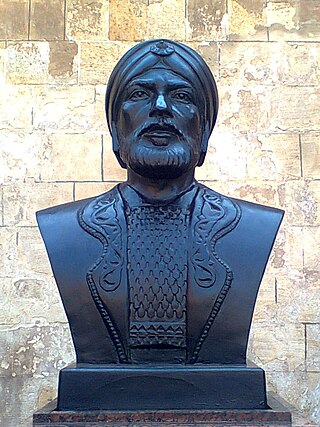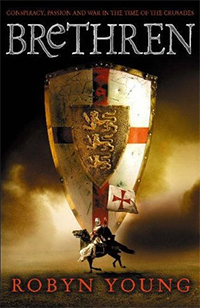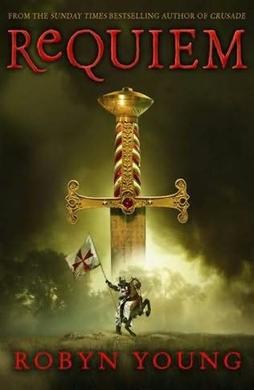
The Eighth Crusade was the second Crusade launched by Louis IX of France, this one against the Hafsid dynasty in Tunisia in 1270. It is also known as the Crusade of Louis IX Against Tunis or the Second Crusade of Louis. The Crusade did not see any significant fighting as Louis died of dysentery shortly after arriving on the shores of Tunisia. The Treaty of Tunis was negotiated between the Crusaders and the Hafsids. No changes in territory occurred, though there were commercial and some political rights granted to the Christians. The Crusaders withdrew back to Europe soon after.

Qalāwūn aṣ-Ṣāliḥī was the seventh Turkic Bahri Mamluk Sultan of Egypt; he ruled from 1279 to 1290. He was called al-Manṣūr Qalāwūn. After having risen in power in the Mamluk court and elite circles, Qalawun eventually held the title of "the victorious king" and gained de facto authority over the sultanate. He is the founder of the Qalawunid dynasty that ruled Egypt for over a century.

Sayf al-Din Qutuz, also romanized as Kutuz or Kotuz and fully al-Malik al-Muẓaffar Sayf ad-Dīn Quṭuz, was the Mamluk Sultan of Egypt. He reigned as Sultan for less than a year, from 1259 until his assassination in 1260, but served as the de facto ruler for two decades.

Al-Ashraf Salāh ad-Dīn Khalil ibn Qalawūn was the eighth Turkic Bahri Mamluk sultan, succeeding his father Qalawun. He served from 12 November 1290 until his assassination in December 1293. He was well known for conquering the last of the Crusader states in Palestine after the siege of Acre in 1291. While walking with a friend, Khalil was attacked and assassinated by Baydara and his followers, who was then killed under the orders of Kitbugha.

The Battle of Fariskur was the last major battle of the Seventh Crusade. The battle was fought on 6 April 1250, between the Crusaders led by King Louis IX of France and Egyptian forces led by Turanshah of the Ayyubid dynasty.

The siege of Acre took place in 1291 and resulted in the Crusaders' losing control of Acre to the Mamluks. It is considered one of the most important battles of the period. Although the crusading movement continued for several more centuries, the capture of the city marked the end of further crusades to the Levant. When Acre fell, the Crusaders lost their last major stronghold of the Crusader Kingdom of Jerusalem. They still maintained a fortress at the northern city of Tartus, engaged in some coastal raids, and attempted an incursion from the tiny island of Ruad; but, when they lost that, too, in a siege in 1302, the Crusaders no longer controlled any part of the Holy Land.

The Zahiriyya Library, also known as the Madrasa al-Zahiriyya, is an Islamic library, madrasa, and mausoleum in Damascus, Syria. It was established in 1277, taking its name from the Mamluk sultan Baybars al-Zahir, who is buried in this place.

Al-Malik al-Zahir Rukn al-Din Baybars al-Bunduqdari, commonly known as Baibars or Baybars and nicknamed Abu al-Futuh, was the fourth Mamluk sultan of Egypt and Syria, of Turkic Kipchak origin, in the Bahri dynasty, succeeding Qutuz. He was one of the commanders of the Egyptian forces that inflicted a defeat on the Seventh Crusade of King Louis IX of France. He also led the vanguard of the Egyptian army at the Battle of Ain Jalut in 1260, which marked the first substantial defeat of the Mongol army and is considered a turning point in history.

The Second Battle of Homs was fought in western Syria on 29 October 1281, between the armies of the Mamluk dynasty of Egypt and the Ilkhanate, a division of the Mongol Empire centered on Iran. The battle was part of Abaqa Khan's attempt at taking Syria from the Egyptians.

Guillaume de Beaujeu, aka William of Beaujeu was the 21st Grand Master of the Knights Templar, from 1273 until his death during the siege of Acre in 1291. He was the last Grand Master to preside in Palestine.
On April 15, 1277, the Mamluk Sultan Baybars marched from Syria into the Mongol-dominated Seljuk Sultanate of Rûm and attacked the Mongol occupation force in the Battle of Elbistan (Abulustayn). Upon reaching Elbistan with at least 10,000 horseman, Baibars made ready for battle with the Mongols, expecting them to be around 30,000. The Mongol forces were smaller but they were supported by Armenians, Georgians and Rum Seljuks that bolstered their numbers. The Mamluk army was led by Baybars and his Bedouin Arab general Isa ibn Muhanna and his Egyptian companionship vizier Zayn al-Din Ahmad bin Hanna.

The Fall of Tripoli was the capture and destruction of the Crusader state, the County of Tripoli, by the Muslim Mamluks. The battle occurred in 1289 and was an important event in the Crusades, as it marked the capture of one of the few remaining major possessions of the Crusaders. The event is represented in a rare surviving illustration from a now fragmentary manuscript known as the 'Cocharelli Codex', thought to have been created in Genoa in the 1330s. The image shows the countess Lucia, Countess of Tripoli and Bartholomew, Bishop of Tortosa sitting in state in the centre of the fortified city, and Qalawun's assault in 1289, with his army depicted massacring the inhabitants fleeing to boats in the harbour and to the nearby island of St Thomas.

Brethren is a novel written by Robyn Young set in the ninth and last crusade. It was published by Hodder and Stoughton in 2006. It took her seven years to write the novel where she was "intrigued by the idea of these medieval warrior monks".

The Mamluk Sultanate, also known as MamlukEgypt or the Mamluk Empire, was a state that ruled Egypt, the Levant and the Hejaz from the mid-13th to early 16th centuries. It was ruled by a military caste of mamluks headed by a sultan. The sultanate was established with the overthrow of the Ayyubid dynasty in Egypt in 1250 and was conquered by the Ottoman Empire in 1517. Mamluk history is generally divided into the Turkic or Bahri period (1250–1382) and the Circassian or Burji period (1382–1517), called after the predominant ethnicity or corps of the ruling Mamluks during these respective eras.

Requiem is a novel by Robyn Young set during the end of the ninth and final crusade. It was first published by E.P. Dutton in 2008.
The wāfidiyya were troops of various ethnic backgrounds who came into the military service of the Mamlūk Sultanate of Egypt and Syria in exchange for asylum. The term is a collective noun formed from the singular wāfid, meaning "one who comes, makes his way, in a delegation or group".

The Mosque of al-Zahir Baybars is a mosque built in Cairo, Egypt by the Mamluk Sultan al-Zahir Baybars al-Bunduqdari through his Vizier Bahaa el-Din bin Hanna and Sanjar al-Shuja‘i.
The siege of Safed was part of the campaign of the Mamlūk sultan Baybars I to reduce the Kingdom of Jerusalem. The castle of Safed belonged to the Knights Templar and put up strong resistance. Direct assault, mining and psychological warfare were all employed to force the garrison to surrender. It was ultimately tricked into surrendering through treachery and the Templars were massacred. Baybars repaired and garrisoned the castle.
Nūr al-Dīn ʿAlī ibn ʿAbd al-Raḥīm ibn Aḥmad al-Kātib al-Malakī al-Muẓaffarī Ibn al-Mughayzil was a Syrian historian of the Mamlūk period. His main work is Dhayl mufarrij al-kurūb fī akhbār banī Ayyūb.

The fall of Outremer describes the history of the Kingdom of Jerusalem from the end of the last European Crusade to the Holy Land in 1272 until the final loss in 1302. The kingdom was the center of Outremer—the four Crusader states—formed after the First Crusade in 1099 and reached its peak in 1187. The loss of Jerusalem in that year began the century-long decline. The years 1272–1302 are fraught with many conflicts throughout the Levant as well as the Mediterranean and Western European regions, and many Crusades were proposed to free the Holy Land from Mamluk control. The major players fighting the Muslims included the kings of England and France, the kingdoms of Cyprus and Sicily, the three Military Orders and Mongol Ilkhanate. Traditionally, the end of Western European presence in the Holy Land is identified as their defeat at the Siege of Acre in 1291, but the Christian forces managed to hold on to the small island fortress of Ruad until 1302.















